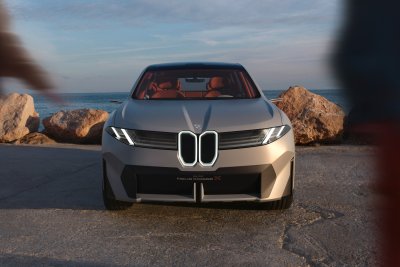BMW Designworks isn’t designing the cars, trains and planes of today. They’re designing for tomorrow, with the help of artificial intelligence.
The subsidiary of BMW Group has design consulting clients across the transportation industry, not just the BMW family of brands (BMW, Mini and Rolls-Royce), including Sirius Aviation, Starlux, the Los Angeles Department of Transportation, Konica Minolta, Ionity, Virgin Hyperloop One and EVA Airways.
Whether it’s with BMW Group projects, like the forthcoming Neue Klasse vehicle range, or reimagining the future of air travel, the Designworks team is strategically using AI to improve its approach to transportation design.
“We’re always developing the most cutting-edge tools and working with our team to figure out how we can upscale our team and create new ways of doing things that enable our design process to create a better experience for our client. [Having] an AI designer for us was an obvious necessity that we wanted to develop as a skill in-house,” Paul Ferraiolo, director of strategic foresight and partnering at the BMW Designworks L.A. studio, told Newsweek.
An AI strategist works under Ferraiolo at the company. Ferraiolo explained: Their job isn’t to classically use AI as most utilize it today. Instead, Designworks is “using AI as part of the creative process to enable more creative exchange, more creative inspiration and work across all of our teams, across interaction design, across automotive design, across industrial design, to create a new process that helps every team and every sort of project and service that we work on.”
Because the company is designing mobility solutions for the future, it uses AI to create projected environments where its designs might exist in the real world.
“We really start at the beginning of any project, understanding the customer and looking into the future to create a future vision. And as part of that, we really believe in this idea of world building, so understanding the future world and the future user that you want to design for,” Ferraiolo said.

BMW

BMW
As part of that design process, many factors are considered. “What are the different values, attitudes, behaviors that you would want?…We’re not using [AI] to design the product, but we are imagining what is that future vision and world. And, how do we tell the story that would allow us to design a better product or service for that future?” Ferraiolo posited.
These are the qualities that an artist would take into account to create a rendering by computer-aided hand in years past, a process that could take days. “With AI, you can iterate that process really quickly. You can ask questions if you’re talking text-based prompts and a large language model, or you can visualize a scenario that you would live in really quickly without having to illustrate that [by hand],” he said.
From there, the company’s designers have a picture of the future that they want to design for. They work from that starting point, within certain guidelines the company has established.
“We’ve created different guidelines based on the specific projects that we are working on,” Ferraiolo said. “We have a general code of conduct for what it means to be working with AI anywhere from watermarking something specifically or calling out that [AI] was used as part of the process. We have it covering everything from confidentiality to AI ethics, and making sure that we’re being respective of creatives, creative ownership, as well as what role we’re using it [for] as part of the process.”
With many projects in the pipeline covered by confidentiality agreements, Ferraiolo can’t speak to what AI-influenced design is in the pipeline right now. However, he was able to point out that the company worked with the team at BMW North America to create a video that was assisted by AI, but not purely made with it, for the Neue Klasse X reveal, about a year ago.











